Selasa, 30 Desember 2008
Grumman F4F Wildcat
window.google_render_ad();
In pure performance, the Zero outclassed the F4F, but with its tough construction and well-trained pilots using appropriate tactics, the Wildcat prevailed. Later in the war, the FM-2, an Eastern-produced version of the Wildcat, flew from escort carriers.
DevelopmentIn 1936, the US Navy published a requirement for a carrier-based fighter, While the Navy first selected the Brewster F2A Buffalo, it authorized Leroy Grumman's Bethpage, Long Island company to build one prototype, the XF4F-2, as an alternative. Experienced builders of carrier planes, the Grumman designers planned the Wildcat for the challenging take-offs and landings on small, heaving carrier decks. With large wings, situated well forward on the fuselage, the plane had very high lift, permitted quick take-offs, slow landings, and excellent maneuverability. But high lift resulted in slower speed, which could only be improved with a more powerful engine.
Grumman test pilot Robert Hall first flew the XF4F-2 in September, 1937. Powered by a Pratt & Whitney R-1830-66 Twin Wasp, rated at 1,050 horsepower, it achieved 290 miles per hour in test flight. The XF4F-2 featured a cantilever wing set midway up the fuselage, all-metal construction, semi-monocoque construction, mill-riveted skin, four .50 caliber machine guns, and main wheels that retracted into the fuselage. Despite the F4F's speedy performance in a 1938 fly-off at Anacostia, the Navy went with the Brewster.
"On its own hook," Grumman improved the design further with the next prototype, the XF4F-3. The "dash Three" had the more powerful R-1830-76 P&W, larger wings, a better machine gun installation, and (ultimately) a higher-mounted tailplane. With a top speed of 335 MPH, it impressed the Navy, and 78 F4F-3 aircraft were ordered in August, 1939.
An export version of the F4F-3, powered by the Wright Cyclone R-1820, served with the British Fleet Air Arm (FAA), as the Martlet Mark I. Other Martlet versions included the Mark II, Mark III, and Mark IV. They served primarily on escort carriers in the Battle of the Atlantic. Among the notable achievements of FAA Martlet pilots was the downing of a four-engine Fw 200 Condor off Gibraltar in September, 1940.
In late 1940 the first F4F-3's arrived with US Navy Squadrons VF-7 and VF-41.
Based on British combat experience, the next version, the XF4F-4, incorporated:
folding wings
six machine guns (two more than in the F4F-3)
self-sealing gas tanks
armor
These add-ons made the "dash Four" heavier and slower than the previous version, which the pilots did not like. But the brass liked the more compact stowage of the folding wings, which enabled more planes to fit in a carrier.© Osprey Publishing Ltd,www.ospreypublishing.com
CombatBy the time of Pearl Harbor the Navy and the Marine Corps had 131 Wildcats in eleven fighting squadrons. At Wake Island, outnumbered the Marine fliers of VMF-211 fought a doomed battle against the Japanese invaders. Captain Henry T. Elrod of VMF-211, while flying an F4F-3, sank a Japanese destroyer, and subsequently lost his life in the land defense of Wake Island. For his combined actions in defense of Wake Island, he was posthumously awarded the Medal of Honor. In February, 1942, the US Navy struck back; carriers Enterprise, Lexington and Yorktown raided forward Japanese bases. When Lexington was sighted and Japanese Betty bombers came after her, Butch O'Hare shot down five of them in minutes. For this skillful heroism, which likely saved the carrier, O'Hare was also awarded the Medal of Honor.
At the Battle of Midway, the four Navy carrier-based Navy squadrons were still adjusting to the "dash Four" Wildcat. Seven F4F's joined the Buffalo-equipped VMF-221, based on Midway Island itself; the first Japanese air raid on the morning of June 4 decimated the squadron, and VMF-221 was out of the battle. Later that morning, the F4F fighting squadrons from Enterprise and Hornet escorted SBD's and TBD's, but did not provide effective cover for the strike planes when they approached the Japanese carriers. The Yorktown fighters, under Jimmy Thach, made more of an impact, and claimed five kills.
These Navy pilots didn't think all that much of the Wildcat. Jimmy Thach, quoted in Eric Bergerud's Fire in the Sky: The Air War in the South Pacific:
In connection with the performance of the Zero fighter, any success we had against the Zero is not due to the performance of the airplane we fly, but is the result of comparatively poor marksmanship on the part of the Japanese, stupid mistakes made by a few of their pilots and superior marksmanship and teamwork on the part of some of our pilots ... The deficiency not only prevents our fighter [the F4F] from properly carrying out its mission but it has had an alarming effect on the morale of the fighter pilots in the Fleet at this time and on those who are going to be sent to the Fleet.
© Osprey Publishing Ltd,www.ospreypublishing.com
Thach and his F4F pilots witnessed the awesome destruction of three carriers in five minutes by the American SBD dive bombers. Later that afternoon, Scott McCuskey and other VF-3 Wildcat pilots flew CAP over Yorktown when the Japanese struck back. Despite claiming 11 Vals, a few got through and crippled the flattop.
GuadalcanalWhen the U.S. forces invaded Guadalcanal in August, 1942, the big prize, the island's strategic importance, was an unfinished Japanese airstrip on the north side of the island. Later that strip would become Henderson Field. Days after the first infantrymen occupied the area, Marine Corps Wildcats landed. In the ensuing weeks and months, those stubby fighters protected the tenuous American hold on the island.
While bloody battles were fought on the ground at Guadalcanal, air power made the difference. Almost every day, Japanese Betty bombers and Zero fighters made the long flight from Rabaul to strike at Guadalcanal. Forewarned by the Coastwatchers and by radar, the F4F's of the "Cactus Air Force" would scramble in time to gain altitude, and then hit the Japanese raiders. In the first few weeks, Major John Smith's VMF-223 flew their Wildcats "into the ground."
The Wildcat was aptly named; it was tricky and unforgiving to fly. Its landing gear was not well-suited to the muddy and dusty conditions of Henderson Field. The controls could be mushy when maneuverability was most needed. There was no way to jettison the hood. The pilot's seat was cramped and too low for optimal visibility. It was not as agile as the Zero. Usually, the F4F pilots tried to zoom through the screening Zeros and go after the bomber directly. With altitude, they could adopt hit-and-run tactics; their rugged construction resisted the Japanese 7.7mm machine gun bullets.
The great Japanese ace Saburo Sakai described the Wildcat in the book Zero:
I had full confidence in my ability to destroy the Grumman and decided to finish off the enemy fighter with only my 7.7mm machine guns. I turned the 20mm. cannon switch to the 'off' position, and closed in. For some strange reason, even after I had poured about five or six hundred rounds of ammunition directly into the Grumman, the airplane did not fall, but kept on flying. I thought this very odd - it had never happened before - and closed the distance between the two airplanes until I could almost reach out and touch the Grumman. To my surprise, the Grumman's rudder and tail were torn to shreds, looking like an old torn piece of rag. With his plane in such condition, no wonder the pilot was unable to continue fighting! ... A Zero which had taken that many bullets would have been a ball of fire by now.
Through 1942 and the relatively less intense first half of 1943, the US Navy and Marine Corps relied, by necessity, on the F4F, and 46 of those pilots 'made ace' in the tough little Grumman. Starting in the sumer of 1943, the Hellcat and Corsair replaced the Wildcat in the Naval services' fighting squadrons.
The Eastern WildcatFrom very early in 1942, it became clear that Grumman would need to focus on the Hellcat program. As part of wartime cooperation, General Motors' Eastern Aircraft Division took over production of the Wildcat. Over the course of the war, Eastern turned out 1,151 FM-1's and 4,777 FM-2's (far more than Grumman ever produced).
At the Battle of Leyte Gulf, FM-2 pilots, flying from escort carriers, distinguished themselves in launching repeated attacks against the Japanese battlewagons, sometimes unarmed!
Top Wildcat Aces
Top USMC and USN Wildcat Aces
Kills
Medals
Squadron
Plane
Joseph Foss
26.0
MH
VMF-121
F4F
John L. Smith
19.0
MH
VMF-223
F4F
Marion E. Carl
18.5
NC
VMF-223
F4F
James E. Swett
15.5
MH
VMF-221
F4FF4U
Lt. Elbert McCuskey (USN)
13.5
NC
VF-3/VF-42/VF-8
F4F/F6F
Robert E. Galer
13.0
MH
VMF-224
F4F
William P. Marontate
13.0
-
VMF-121
F4F
Kenneth D. Frazier
12.5
-
VMF-223
F4F
Loren D. Everton
12.0
-
VMF-212
F4F
Harold W. Bauer
11.0
MH
VMF-212
F4F
Jefferson DeBlanc
9.0
MH
VMF-112
F4F
Stanley W. "Swede" Vejtasa (USN)
10.3
NC
VF-10
F4F
Whitey Feightner (USN)
9.0
-
VF-10/VF-8
F4F/F6F
Ralph E. Elliott (USN)
9.0
-
VC-27
FM-2
Edward "Butch" O'Hare (USN)
7.0
MH
VF-3
F4F
Jumat, 19 Desember 2008
BREN ENGLISH MAIN LMG IN WW2

The Bren (from Brno, the Czechoslovak city of design, and Enfield, the location of the British Royal Small Arms Factory), usually called the Bren Gun, was a series of light machine guns adopted by Britain in the 1930s and used in various roles until 1991. While it is best known for its role as the British and Commonwealth forces' primary infantry light machine gun (LMG) in World War II, it was also used in the Korean War and saw service throughout the later half of the 20th century including the Falklands War and the 1991 Gulf War.
The Bren was a modified version of a Czechoslovak-designed light machine gun, the ZB vz.26, which British Army officials had tested during a firearms service competition in the 1930s. The later Bren featured a distinctive curved box magazine, conical flash hider and quick change barrel. In the 1950s the Bren was rebarrelled to accept the 7.62x51mm NATO cartridge. Although fitted with a bipod, it could also be mounted on a tripod or vehicle-mounted.
The Bren was replaced as the section LMG by the L7 general purpose machine gun (GPMG), a heavier belt-fed weapon. This was in turn supplemented in the 1980s by the L86 Light Support Weapon firing the 5.56x45mm NATO round, leaving the Bren only in use on some vehicles.
As of November 2007, the Bren is still manufactured by Indian Ordnance Factories as the "Gun, Machine 7.62mm 1B".[1]
Service
In general, the Bren was considered a reliable and effective light machine gun, though in North Africa it wa s reported to jam regularly unless kept very clean and free of sand.[2]
s reported to jam regularly unless kept very clean and free of sand.[2]
Its 30-round magazine was in practice usually filled with 28 or 29 rounds to prevent jams and avoid wearing out the magazine spring. Care needed to be taken with magazine loading to ensure that the .303 cartridge rims did not overlap the wrong way, causing a jam. The rounds had to be loaded the correct way, each round ahead of the previous round. There was also a 100-round drum magazine available for the Bren used in the anti-aircraft role.
The Bren was officially operated by a two man crew: a gunner to fire and carry the Bren, and a reloader to reload the gun and replace the barrel when it overheated—the latch in front of the magazine was rotated to unlock the barrel so that it could be replaced: the carrying handle was used to grip the hot barrel without risk of burning. The reloader carried extra ammunition and barrels. During wartime, however, the two-man crew concept was abandoned and the weapon was commonly operated by one man, the gunner (as depicted in the picture to the right).
 The Bren had an effective range of around 600 yards (550 m) when fired from a prone position with a bipod. Initial versions of the weapon were sometimes considered too accurate because the cone or pattern of fire was extremely concentrated, resulting in multiple hits on one or two enemies, with other enemy soldiers going untouched. More than a few soldiers expressed a preference for worn-out barrels in order to spread the cone of fire among several targets. Later versions of the Bren addressed this issue by providing a wider cone of fire.[2]
The Bren had an effective range of around 600 yards (550 m) when fired from a prone position with a bipod. Initial versions of the weapon were sometimes considered too accurate because the cone or pattern of fire was extremely concentrated, resulting in multiple hits on one or two enemies, with other enemy soldiers going untouched. More than a few soldiers expressed a preference for worn-out barrels in order to spread the cone of fire among several targets. Later versions of the Bren addressed this issue by providing a wider cone of fire.[2]
For a light machine gun of the interwar and early WWII era the Bren was about average in weight. On long marches in non-operational areas it was often partially disassembled and its parts carried by two soldiers. Writing about his experiences in the infantry during the Burma campaign,[3] the author George MacDonald Fraser stated that one Bren gun was issued to each eight-man section. One soldier would be the gunner and another would be his 'number two', who would carry extra ammunition and the spare barrel and change magazines in combat. The top-mounted magazine vibrated and moved during fire, making the weapon more visible in combat, and many Bren gunners used paint or improvised canvas covers to disguise the prominent magazine.[4]
Realising the need for additional section-level firepower, the British Army endeavoured to issue the Bren in great numbers, with a stated goal of one Bren to every four private soldiers.[2]
On occasion, a Bren gunner would use his weapon on the move supported by a sling, much like an automatic rifle, though generally the Bren was fired from the prone position using the attached bipod.[citation needed] Each British soldier's equipment normally included two magazines for his section's Bren gun, and every man would be trained to fire the Bren in case of an emergency, though these soldiers did not receive a Bren proficiency badge.[citation needed]
The Bren was also used on many vehicles as well, including Universal Carriers to which it gave the alternative name "Bren Gun Carrier", on tanks, and armoured cars. However, on tanks it was not used in the co-axial role but on a pintle mount. The co-axial requirement was filled by the Vickers or the BESA, the latter being another Czech machine gun design adopted by the British.
It was popular with British troops who respected the Bren for its reliability and combat effectiveness. The quality of the materials used would often ensure minimal jamming. When the gun did jam or had some foreign object stuck in it, the operator could adjust the four-position gas regulator to feed more gas to the piston increasing the power to operate the mechanism. It was even said that all problems with the Bren could simply be cleared by hitting the gun, turning the gauge, or doing both. Note that the barrel needed to be unlocked and slid forward slightly to allow the regulator to be turned.
The Bren's direct ancestor, the Czechoslovak ZB vz. 26, was also used in WWII by German forces, including units of the Waffen SS. Many 7.92 mm ZB light machine guns were shipped to China where they were employed first against the Japanese in WWII, and later against UN forces in Korea, including British and Commonwealth units. Some ex-Chinese Czech ZB weapons were also in use in the early stages of the Vietnam conflict.
The production of a 7.92 mm round model for the Far East was made by Inglis of Canada.
With the British Army's adoption of the 7.62 mm NATO cartridge, the Bren was re-designed to 7.62 mm calibre, fitted with a new barrel and magazine, and continued in service. It was redesignated as the L4 Light Machine Gun and continued in British Army service into the 1990s. The change from a rimmed to rimless cartridge and nearly-straight magazine improved feeding considerably, and allowed use of 20-round magazines from the 7.62 mm L1A1 Self Loading Rifle. The conical flash hider was also lost in the transition, being replaced by the slotted type similar to that of the contemporary L1 rifle and L7 General Purpose Machine Gun.
The magazine from the 7.62 mm version of the L4 also fitted the L1A1 however the magazine spring was not up to the task of providing enough upward pressure to feed rounds correctly.
Completion of the move to a 5.56 mm NATO cartridge led to the Bren/L4 being removed from the list of approved weapons and then withdrawn from service. The fact that Bren guns remained in service for so many years with so many different countries in so many wars says much about the quality of the basic design.
The Mark III Bren remains in limited use with the Army Reserve of the Irish Defence Forces, although in most units it has been replaced by the 7.62 mm FN MAG (GPMG). The weapon was popular with the soldiers who fired it (known as Brenners) as it was light, durable and had a reputation for accuracy. The most notable use of the Bren by Irish forces was in the Congo during the 1960s, when the Bren was the regular army's standard section automatic weapon.
Kamis, 11 Desember 2008
OPERATION BODENPLATTE 1-1-1945, LAST LUFTWAFFE MAJOR AIR RAID

So secret was Operation Bodenplatte that the Germans own ground forces were not notified of the large formations of German fighters that would be flying overhead. This resulted in at least one casualty for the JG11 as they were assaulted by friendly fire on their way to Asch. Credit must be given to the German pilots for not breaking radio silence to call off the ground fire. On the return trip several more JG11 and many other German fighters fell to friendly fire before the German guns could be called off.
As the JG11 approached Asch, 8 P47's of the 390th were just forming up over Asch to head out over the Ardennes in search of German armor. As the 390th finished forming up they spotted flak bursts over the Ophoven field. At this same moment Lt Col. John Meyer was just beginning to roll down the runway. He also saw the flak bursts and radioed the tower to inquire; the tower had nothing to report. Heading for Ophoven to investigate, the 390th was surprised to see a large formation of FW190's and Me109's approaching Asch from the northeast at 1500 ft
The 8 P47's of the 390th jettisoned their bombs and external tanks and attacked, causing confusion among the German attackers and breaking up the formation. This turned out to be a key blow to the JG11, without which the mustangs of the 487th may not have so easily taken to the air. The 390th claimed 7 enemy aircraft in this attack taking a loss of only one.
 Meanwhile Meyer was lifting off with the rest of the 487th behind him. As he rose from the runway he found himself faced with the oncoming JG11. With a full load of fuel in his fuselage tank, making low altitude maneuvering difficult, and gear still retracting he fired at an oncoming FW190 scoring hits and sending the enemy aircraft crashing into the field. Meyer went on to claim a second Fw190 before the battle was over.
Meanwhile Meyer was lifting off with the rest of the 487th behind him. As he rose from the runway he found himself faced with the oncoming JG11. With a full load of fuel in his fuselage tank, making low altitude maneuvering difficult, and gear still retracting he fired at an oncoming FW190 scoring hits and sending the enemy aircraft crashing into the field. Meyer went on to claim a second Fw190 before the battle was over.The battle over Asch went on for 30 minutes. 11 pilots of the 487th claimed 23 victories while sustaining no losses, and just three aircraft damaged in the air. I will leave the adventures of each pilot to be told by them through their personal combat logs and memoirs.
The 390th and 487th defended the airbase at Asch so well that only one Mustang was damaged on the ground and no casualties were reported. The actions of the 487th in taking off under fire and performing so well at such a disadvantage earned the unit the only Distinguished Unit Citation given to a fighter squadron in the Northwestern European theater of operation.
The total estimated losses of the JG11 range from 24 to 40. Given the credited victories of the 487th (23), 390th (7), 391st (2), and ground gunners (7) along with at least one aircraft destroyed by friendly flak in route, the number of 40 seems to hold up. However, there was undoubtedly some double counting of victories claimed and some victories that were not confirmed. But more Important then the numbers was the loss of experienced Luftwaffe leaders and pilots. None of JG11's flight leaders returned from this mission
Sabtu, 06 Desember 2008
Battle of Iwo Jima (1945)
 By 1944, America and her allies in the Pacific War had the ascendancy. In the west, the Japanese were being turned back in Burma and island hopping had isolated Japanese forces in the eastern sector. Combined with the attacks on Iwo Jima, was America’s desire to finally destroy Japan’s merchant fleet so that the Japanese mainland could not be supplied from the food-rich sectors of South East Asia which Japan still had control over. Linked to this, was the destruction of Japan’s remaining industrial base by the bombing of it by the American airforce.
By 1944, America and her allies in the Pacific War had the ascendancy. In the west, the Japanese were being turned back in Burma and island hopping had isolated Japanese forces in the eastern sector. Combined with the attacks on Iwo Jima, was America’s desire to finally destroy Japan’s merchant fleet so that the Japanese mainland could not be supplied from the food-rich sectors of South East Asia which Japan still had control over. Linked to this, was the destruction of Japan’s remaining industrial base by the bombing of it by the American airforce.
Iwo Jima is a very small Pacific island – just over 4.5 miles long and 2.5 miles wide which lies at the foot of the Bonin chain of islands, south of the main Japanese island of Honshu.
Despite its size, Iwo Jima was considered to have great tactical importance. There were two airfields on the island – under Japan’s control; they could be used by Japanese fighter planes to attack American bombers on their flights to Japan. Under American control, the airfields could be used as emergency landing bases for damaged airplanes in the bombing raids. They could also be used for American fighter planes to escort the bombers, as they needed smaller runways for take-off.
 Knowing that the island was of such importance, the Japanese were determined to keep control of it. There were about 22,000 soldiers under the command of Lieutenant-General Kuribayashi. These men had had the time to build strong defensive positions throughout the island but especially in the north. Kuribayashi knew that his options for launching attacks were extremely limited because of the small size of the island. In fact, his options to do anything other than defend ferociously were extremely limited.
Knowing that the island was of such importance, the Japanese were determined to keep control of it. There were about 22,000 soldiers under the command of Lieutenant-General Kuribayashi. These men had had the time to build strong defensive positions throughout the island but especially in the north. Kuribayashi knew that his options for launching attacks were extremely limited because of the small size of the island. In fact, his options to do anything other than defend ferociously were extremely limited.
America had vast reserves at their disposal. Iwo Jima was ‘softened up’ by bombing raids for more than two months before the actual amphibious assault. For three days prior to the attack, six American battleships had launched a continuous barrage on the island. Within the region, the Americans were led by Admiral Raymond Spruance – though the overall commander of the campaign was Admiral Chester Nimitz. The landing forces were under the command of Lieutenant-General Holland ‘Howling Mad’ Smith. The bulk of the amphibious attack was done by Marines.
 The first day of the landings was February 19th, 1945. The Marines took heavy casualties, as the American bombings had not been effective. What it had done was to churn up the beaches and the immediate hinterland and had given the Japanese far more opportunities to find hiding-holes for snipers. It also meant that American movement inland was hindered as the area had been so heavily bombed. A few well placed Japanese snipers could hold up an American advance for hours.
The first day of the landings was February 19th, 1945. The Marines took heavy casualties, as the American bombings had not been effective. What it had done was to churn up the beaches and the immediate hinterland and had given the Japanese far more opportunities to find hiding-holes for snipers. It also meant that American movement inland was hindered as the area had been so heavily bombed. A few well placed Japanese snipers could hold up an American advance for hours.
However, the Americans had cut the island in two by the end of the first day – despite taking over 2,400 casualties. On Day 2, the Marines attacked Mount Suribachi. Here they found fanatical Japanese defence and Suribachi was taken on February 23rd after three days of fighting.
Iwo Jima proved a difficult and bloody target to take – frequently the Americans only advanced at several hundred metres per day. By March 11th, the Japanese were trapped in an area around Kitano Point, the island’s most northerly extremity. By March 16th, the island was declared secure and all resistance had ceased by March 26th.
The tiny island had taken America over one month to take. The Marines lost 6,891 men killed and 18,070 wounded. Out of the 22,000 Japanese soldiers on the island, only 212 were taken prisoners. What the battle did show the Americans was how far the Japanese would go to defend their country – a decision that was to influence the use of the atomic bombs in Hiroshima and Nagasaki.
Kamis, 04 Desember 2008
7th Armoured Division, "THE DESSERT RATS"

The 7th Armoured Division was a British armoured division which saw service during the Second World War where its exploits made it famous as the Desert Rats.
After the Munich Crisis, the division was formed in Egypt during 1938 as the Mobile Division (Egypt)[1] and its first divisional commander was the acclaimed tank theorist Major-General Sir Percy Hobart. During January 1940, the name of the unit was changed to the 7th Armoured Division[1]. It was during this period that the nickname "Desert Rats" was coined.
The division fought in every major battle during the North African Campaign; later it would land and fight in Sicily and Italy before being withdrawn to the United Kingdom where it prepared to fight in North West Europe. It began landing in Normandy during the afternoon of June 6 and fought its way across Europe ending the war in Kiel and Hamburg, Germany. The 7th Armoured Brigade was detached from the division during early 1942 and fought the Japanese during the fighting in Burma before it returned to the Mediterranean Theatre and fought in Italy.
Although the division was disbanded during the 1950s, the history, name and the famous 'Desert Rat' flash is carried on by the 7th Armoured Brigade.[2]
North Africa
In December 1939, Major-General Sir Michael O'Moore Creagh succeeded Hobart who had fallen afoul of his superiors.
The unit was meant to be equipped with 220 tanks. However, at the outbreak of war the 'Mobile Force' had only 65. Most of the unit's troops had already been deployed for two years by 1940 and it took as long as three months for mail to arrive.
On 16 February 1940, the Mobile Division became the 7th Armoured Division.[1] The Desert Rat divisional flash was adopted about the same time. It originated from a sketch of a jerboa drawn by the divisional commander's wife after a visit to the Cairo Zoo.
After the Italian declaration of war, the Western Desert Force was massively outnumbered. However, the Italians proved to be no match for the British. The Western Desert Force captured 250,000 Italians in the early engagements in 1940.
During the 1941 Italian retreat, Major-General Richard O'Connor, the Western Desert Force commander, ordered the Desert Rats to travel south of the Jebel Akhdar and cut off the Italian forces at Beda Fomm, while Australian forces pushed the Italians west. As the tanks were unable to travel fast enough, the manoeuvre was led by an ad hoc brigade of armoured cars, towed artillery and infantry which completed the trip in 30 hours, cutting off the Italian retreat and destroying the Italian Tenth Army. Lieutenant-Colonel John Combe led this ad hoc group which was known as "Combe Force" after him.
The Italians proved so weak that German dictator Adolf Hitler was forced to send reinforcements (Afrika Korps) to stiffen them under the command of General Erwin Rommel.
The Western Desert Force later became HQ XIII Corps, one of the major parts of Eighth Army. The 7th Armoured Division took part in most of the major battles of the North African Campaign, including both Battles of El Alamein (see First Battle of El Alamein and Second Battle of El Alamein for details). It also participated in the destruction of Axis forces in North Africa in Tunisia in 1943.
Minggu, 09 November 2008
Company E/506th P.I.R. (Band of Brothers) in WW2
Update, May 2002: My 4th book: '101st Airborne-The Screaming Eagles at Normandy' is now available directly from the webmaster-see Books page. This hardcover work debuted in April of 2001 and contains totally different material in stories and photos from my 1st book with a similar title. It is filled with facts, and stories which were never told before, and rare photos of 101st troopers IN Normandy which are not available anywhere else. Some 200 of these photos are being shown to the public for the first time since WW2. The author has interviewed over 900 WW2 vets of the 101st Airborne over a 30 year time period and many have shared their personal photos and stories to make this book possible. No other book on the subject has this unique combination of features.
If you enjoyed the miniseries and want to learn more about what the entire 101st Division experienced and accomplished in the great D-Day invasion, you'll devour the contents of this book. You can also order from Amazon.com, from the MBI warehouse at 1-800-458-0454, or find it at most Barnes & Noble, Borders Books, or Books a Million retail stores.
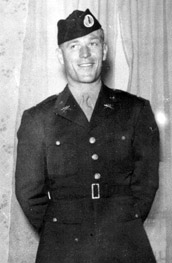
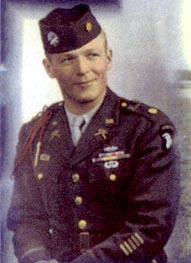
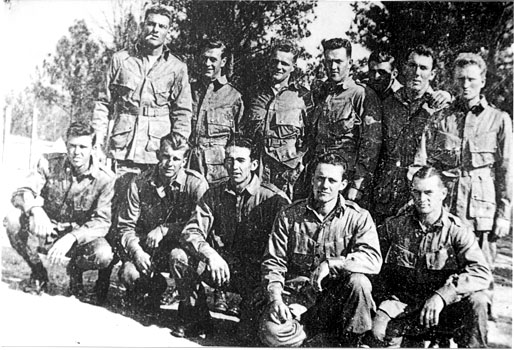
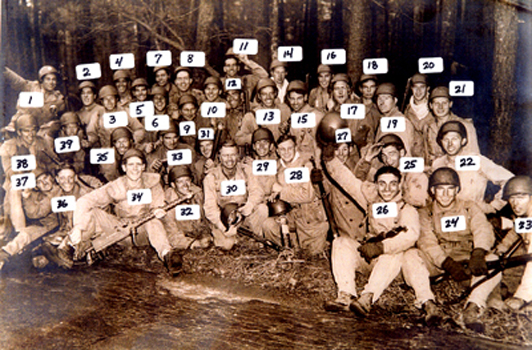
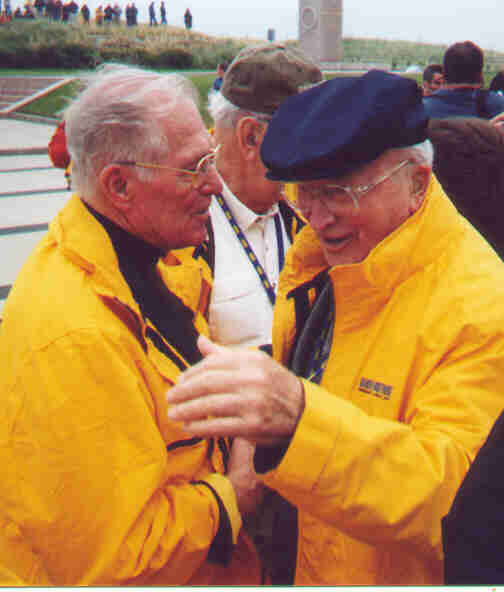
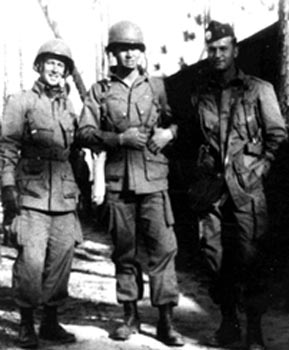
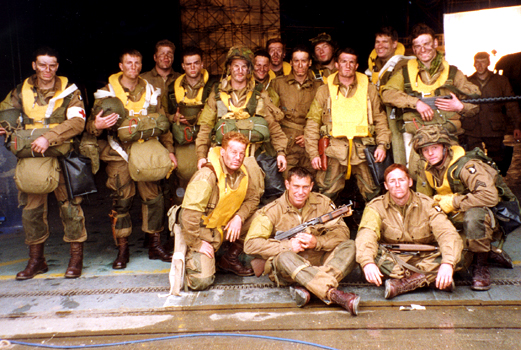
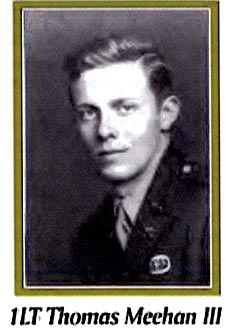
Dearest Anne:
In a few hours I'm going to take the best company of men in the world into France. We'll give the bastards hell. Strangely, I'm not particularly scared. But in my heart is a terrific longing to hold you in my arms. I love you Sweetheart-forever. Your Tom
The plane bearing Lt Meehan and his entire stick of jumpers was hit by German ground fire near St Mere Eglise. All aboard were lost when the plane went-in between Beuzeville au Plain and Haut Fornel. A monument was dedicated on 6 June 2000, at Beuzeville, listing the names of those aboard. Excerpts from a thoughtful letter written by Lt Meehan, plus more biographical information, can be found posted by Barrie on the AWON website (see Links). Courtesy Barrie Meehan Meller and Dan Potter-posted by the webmaster on Tom Meehan's birthday, July 9th(2001).
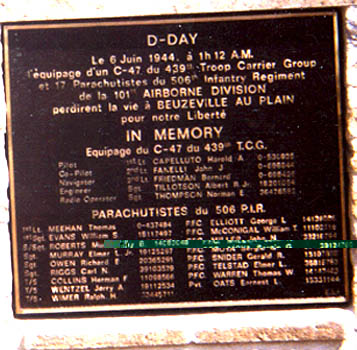
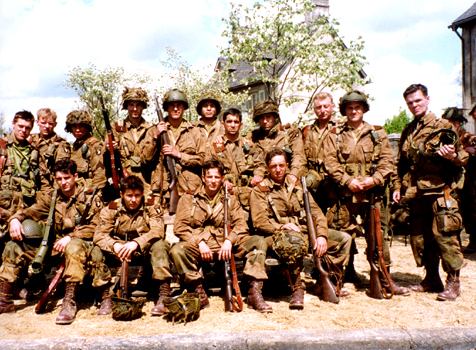
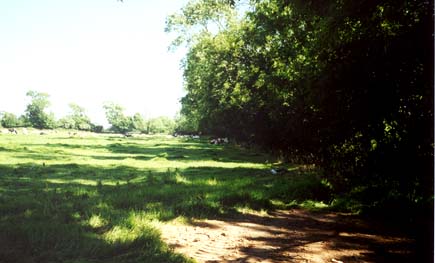
About a dozen soldiers were decorated for this crucial action, which no doubt saved many American lives among the seaborne forces landing at Exit #2. Lt R.D. Winters received the Distinguished Service Cross, and Pfc Loraine was among the soldiers who received the Silver Star. Loraine's Citation appears below. The wording of the citation may be misleading, as the beach was over five miles distant, not at "close range". This made direct observation by the enemy gunners impossible. The guns were sited on the shoreline, depending on radio communications from observers closer to the Channel for adjustments. Also bear in mind that the enemy battery probably consisted of 105's rather than 88mm artillery. Above photo courtesy F. Raine Remsberg, Bando f Brothers tour, 2000.
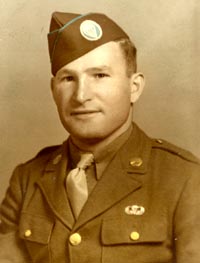
Webmaster's note: Gerald Loraine received a second Silver Star Medal for actions in Holland and in postwar years, he claimed to be the first member of the 101st Airborne to win that medal twice-I cannot verify that he was the first to accomplish that, and Fred Bahlau would be a close second.
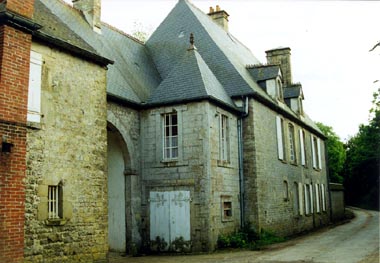
Another note from the webmaster-on my last 2 visits to this area (1999 and 2000), I was disappointed to see on the ground between the south end of the treeline and the entrance to Brecourt Manor, a huge pile of that blight of modern civilization: discarded tires! Somehow it seems an out-of-place desecration to this hallowed ground. But life goes on for farmers in France. For fifty years after D-Day, no errection of new buildings was allowed in the Cotentin, behind Utah Beach. I can attest that in 1989, on my first visit, things were still pretty primitive. But in just 12 years since that time, many new houses and business places have sprung-up in the area between the north edge of Carentan, and the village of Ravenoville. It is a shame, but for example, 'Gillis' Corner' at the edge of DZ 'D' at la Haute Addeville now has two new houses built there, and someday will just be the corner of some residential street. Will future French residents ever realize the American blood that was shed on their block for the liberation of their country? In 2000, I told the residents of the house at Gillis' Corner that Pfc James J. Luce of F/501 was fatally wounded about 50 feet from their front door.
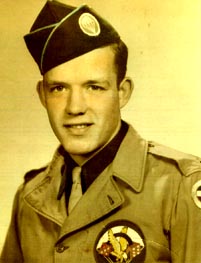
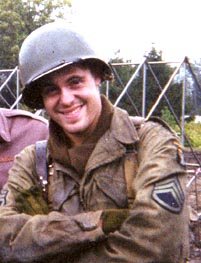
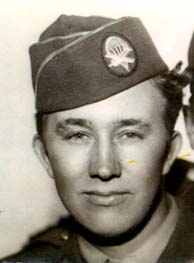
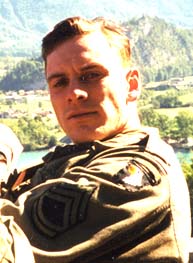
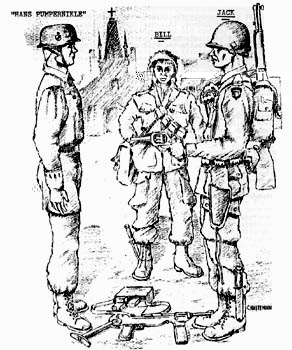
Above, one of Pat Christenson's wonderful sketches, reconstructing an incident in Holland. "Hans Pumpernikle" (ha!) is obviously a German Fallschirmjager (parachutist). Jack appears to be armed with a big hawg leg, in the form of a WW1 vintage .45 revolver. This hilarious sketch graced the cover of the Five-0-Sink Newsletter in June, 1989.
Kamis, 14 Agustus 2008
the top scoring aces of ww2 country by country.
hiroyoshi nishizawa japanese 87 kills killed 26th october 1944
ivan kozhedub russian 62 kills
prince constantine cantacuzenne romanian 60 kills
marmaduke *pat* pattle south african 51 kills kia 20/4/41
richard bong american 40 kills
mato dukovac croatian 40 kills
james johnson british 38 kills
deszo szentgyiorgyi hungarian 34 kills
jan rezoak slovakian 32 kills
george beurling canadian 31 kills
clive caldwell australian 29 kills
colin gray new zealander 28 kills
adriano visconti italian 26 kills killed 29th april 1945
marcel albert* french 23 kills
stanislaw skalski polish 22 kills
karel kuttelwascher czech 18 kills
svein heglund norwegian 15 kills
li kwei-tan chinese 12 kills
kaj birksted danish 11 kills
yvan georges du monceau de bergandel belgian 8 kills
cudomir toplodolski bulgarian 8 kills
*marcel albert has been placed as the top french scorer as i recently had an argument with erich over pierre clostermanns claims.
pilots level on the number of kills have been placed in alphabetical order.
Kamis, 24 Juli 2008
The Battle Of The Atlantic 1939-1945
Initially the Royal Navy lacked sufficient convoy escorts and air cover was almost non-existent. Large numbers of 1,000 ton coastal escorts, 62 metres long and based on a whalecatcher design were built. Despite their small size these Corvettes were used as ocean escorts but were very uncomfortable in heavy weather. They carried a 102mm gun and up to seventy two depth charges. The Corvettes played a key role in the Battle of the Atlantic. In 1942 ocean going escorts called Frigates, 1,400 ton ships just over 90 metres long and capable of 20 knots, were introduced.
In 1941 more ships were placed in convoys, now escorted all the way across the Atlantic. Advances in radio intelligence and code breaking allowed these convoys to be routed around the U-boats. The German effort was largely contained until the USA entered the war and delays in introducing coastal convoys off the American coast and in the Caribbean boosted losses once more. Convoys were introduced to solve this problem and, by late 1942, the U-boats returned in larger numbers to the mid-Atlantic. They were searching for weaknesses in convoy defences that could be exploited by 'wolf packs' of U-boats.
The Battle of the Atlantic, as it became known, now rose to a peak. Britain had lost the ability to decrypt U-boat signals but, in any case, there were too many U-boats to avoid. The Germans concentrated their wolf packs where air cover was not available, the 'black hole' in mid-Atlantic.
A combination of factors finally tilted the balance against the Germans. The British again broke the German codes so they could concentrate escorts around threatened convoys. Most importantly the RAF agreed to the Admiralty's demands for very long range Liberator maritime patrol aircraft to support the escorts in the 'black hole'. Small escort carriers were also deployed to protect convoys.
The German offensive was failing and on 23 May 1943 the Germans withdrew their U-boats from the Atlantic campaign. This withdrawal was only temporary but later German efforts were broken by the now formidable escort forces. The Battle of the Atlantic had been won. By the end of the war the losses suffered by both sides were appalling. The Allies lost 30,000 seamen and 2,500 merchant ships were sunk. More than 28,000 German submariners were killed and 781 U-boats destroyed.
(http://www.royal-navy.mod.uk)
Senin, 07 Juli 2008
Me 109, the great warplane that possible never was

The Messerschmitt Bf 109, like the North American P-51,1 might have been the plane that never was. Bayerische Flugzeugwerke (Bavarian Aircraft Company/BFW) was initially blocked from being sent contracts due to a long running feud between Willy Messerschmitt and the Secretary of State for Aviation, Erhard Milch.2 In order to save BFW from liquidation,3 Messerschmitt and his joint manager Herr Kokothanki, obtained a contract from a Romanian cartel, to develop the M-37 light transport. Protests were made against Messerschmitt's acceptance of a foreign contract, but Willy Messerschmitt argued that due to a lack of home support, he was forced to seek contracts outside of Germany. Consequently, BFW was awarded a contract for fighter development.4
In 1934 the German Air Ministry (Reichs Luftsfahrt Ministerium / RLM) issued specifications for a new fighter monoplane to replace the Heinkel He 51 and Arado 68 biplanes.5 It was to be equipped with at least two MG-17 7.9 millimeter machine guns, and to have the capability of utilizing the new liquid cooled vee 12 engines under development by Junkers and Daimler-Benz. The request was sent to Focke-Wulf, Arado, Heinkel and BFW. Focke-Wulf submitted the Fw 159V1, Arado the Ar 80V1 and Heinkel the He 112. The Bf 109 was the winner in the trials, exceeding its nearest rival, the Heinkel He 112, by 17 mph.6 Only the He 112 provided any other serious competition besides the Bf 109 in the trials, and ten preproduction prototypes were ordered for the Heinkel He 112 and Bf 109.
Selasa, 03 Juni 2008
TUSKEGEE AIRMEN, AFRO AMERICAN HEROIC SCENE IN WW2
The "Tuskegee Airmen" refers to all who were involved in the Army Air Corps program to train African-Americans to fly and maintain combat aircraft. The Tuskegee Airmen included pilots, navigators, bombardiers, maintenance and support staff, instructors, and all the personnel who kept the planes in the air.
 The primary flight training for these servicemembers took place at the Division of Aeronautics of Tuskegee Institute. Air Corps officials built a separate facility at Tuskegee Army Air Field to train the pilots. The Tuskegee Airmen not only battled enemies during wartime but also fought against racism and segregation thus proving they were just as good as any other pilot. Racism was common during World War II and many people did not want blacks to become pilots. They trained in overcrowded classrooms and airstrips, and suffered from the racist attitude of some military officials. The Tuskegee Airman suffered many hardships, but they proved themselves to be world class pilots.
The primary flight training for these servicemembers took place at the Division of Aeronautics of Tuskegee Institute. Air Corps officials built a separate facility at Tuskegee Army Air Field to train the pilots. The Tuskegee Airmen not only battled enemies during wartime but also fought against racism and segregation thus proving they were just as good as any other pilot. Racism was common during World War II and many people did not want blacks to become pilots. They trained in overcrowded classrooms and airstrips, and suffered from the racist attitude of some military officials. The Tuskegee Airman suffered many hardships, but they proved themselves to be world class pilots. Even though the Tuskegee Airmen proved their worth as military pilots they were still forced to operate in segregated units and did not fight alongside their white countrymen.
One honor the Tuskegee Airmen hold true is that they never lost a bomber under their escort during World War II. Such honors as this earned the men the nickname "Red Tail Angels." The Airmen earned this title because of the red paint on the propeller and tail of their planes.
In March of 1942 George Roberts, Benjamin Davis Jr., Charles BeBow Jr., Mac Ross and Lemuel Custis received silver wings of Army Air Force pilots. These men completed the standard Army flight classroom instruction and many hours of flight time. Receiving their silver wings marked a milestone in being the first African-Americans to qualify as military pilots in any branch of the armed forces.
By the end of the war, 992 men had graduated from pilot training at Tuskegee; 450 were sent overseas for combat assignment. During the same period, about 150 lost their lives while in training or on combat flights. These black airman manage to destroy or damage over 409 German airplanes, 950 ground units, and sank a battleship destroyer. They ran over 200 bomber escort missions during World War II.
On Nov. 6, 1998, President Clinton approved Public Law 105-355, which established the Tuskegee Airmen National Historic Site at Moton Field in Tuskegee, Ala., to commemorate and interpret the heroic actions of the Tuskegee Airmen during World War II.
Major contribution by Airman Brian Butkus, 375th Airlift Wing Public Affairs.
Selasa, 08 April 2008
SMLE, Commonwealth Rifle in WW2
 The Lee-Enfield series of rifles was born in 1895 as a marriage between the magazine and bolt action, designed by the J. P. Lee, and the new pattern of barrel rifling, designed at the Royal Small Arms Factory (RSAF) at Enfield. Originally known as Lee-Metford, this design was adopted by British army in 1888 and used a Metford pattern rifling with shallow groves, intended to be used with ammunition loaded with black powder. Introduction of the smokeless powders in the form of the Cordite showed that the Metford rifling was very short-living, so it was soon replaced with Enfield rifling, with 5 traditional land and grooves and left hand pitch.
The Lee-Enfield series of rifles was born in 1895 as a marriage between the magazine and bolt action, designed by the J. P. Lee, and the new pattern of barrel rifling, designed at the Royal Small Arms Factory (RSAF) at Enfield. Originally known as Lee-Metford, this design was adopted by British army in 1888 and used a Metford pattern rifling with shallow groves, intended to be used with ammunition loaded with black powder. Introduction of the smokeless powders in the form of the Cordite showed that the Metford rifling was very short-living, so it was soon replaced with Enfield rifling, with 5 traditional land and grooves and left hand pitch.  Early Lee-Enfield rifles, officially known as a ".303 caliber, Rifle, Magazine, Lee-Enfield", were carried by the British army through the Boer war (South Africa) of 1899-1902, and Boers, armed with their Mausers, taught to the Brits some hard lessons. And, unlike some other Empires, Brits were quick lo learn. In 1903, they introduced a new design, which improved over the older Lee-Metfords and Lee-Enfields in some important respects. The main improvements was the introduction of the "universal" rifle idea.
Early Lee-Enfield rifles, officially known as a ".303 caliber, Rifle, Magazine, Lee-Enfield", were carried by the British army through the Boer war (South Africa) of 1899-1902, and Boers, armed with their Mausers, taught to the Brits some hard lessons. And, unlike some other Empires, Brits were quick lo learn. In 1903, they introduced a new design, which improved over the older Lee-Metfords and Lee-Enfields in some important respects. The main improvements was the introduction of the "universal" rifle idea.  Development and introduction into service of this rifle was accompanied with constant complaints of some "theorists", which stated that this rifle would be no good neither for infantry, nor for cavalry, so RSAF was set do design another rifle, patterned after the German Mauser, which also should be more suitable for mass production, than the SMLE. This rifle finally appeared in 1914 as an ".303 caliber Enfield Pattern 1914 rifle", or simply a P-14. With the outbreak of the Great war British troops were still armed with the "poor" SMLE Mk.III rifles, which soon turned far from any "poor", giving some hard time to the Germans. In fact, the SMLE Mk.III was a really good rifle, quite accurate, reliable and suitable for rapid and accurate firing. British soldiers were rigorously trained for both individual and volley fire marksmanship, and were routinely capable of firing 30 aimed shots per minute, which was quite a rate of fire for any non-automatic rifle. There were times when advancing Germans were impressed that they were under the machine gun fire, when Tommie used their salvo-firing techniques.
Development and introduction into service of this rifle was accompanied with constant complaints of some "theorists", which stated that this rifle would be no good neither for infantry, nor for cavalry, so RSAF was set do design another rifle, patterned after the German Mauser, which also should be more suitable for mass production, than the SMLE. This rifle finally appeared in 1914 as an ".303 caliber Enfield Pattern 1914 rifle", or simply a P-14. With the outbreak of the Great war British troops were still armed with the "poor" SMLE Mk.III rifles, which soon turned far from any "poor", giving some hard time to the Germans. In fact, the SMLE Mk.III was a really good rifle, quite accurate, reliable and suitable for rapid and accurate firing. British soldiers were rigorously trained for both individual and volley fire marksmanship, and were routinely capable of firing 30 aimed shots per minute, which was quite a rate of fire for any non-automatic rifle. There were times when advancing Germans were impressed that they were under the machine gun fire, when Tommie used their salvo-firing techniques.  The latter feature was substituted by the simplified flip-up rear sights for wartime production, and this version became the No.4 Mk.1* rifle. By the end of the World War 2, when British and Commonwealth troops (also armed with SMLEs) started to fight in jungles of the South-East Asia, it was soon discovered that a "short" SMLE was still not short enough for the jungle combat, so a carbine version was adopted late in the 1944 in the form of the No.5 "jungle carbine". This gun was somewhat lighter and handier than No.4, but suffered from the "wandering zero" problems, which meant that the point of impact wandered during the time. The muzzle flash and recoil were also too strong, despite the flash-hider and rubber buttpad.
The latter feature was substituted by the simplified flip-up rear sights for wartime production, and this version became the No.4 Mk.1* rifle. By the end of the World War 2, when British and Commonwealth troops (also armed with SMLEs) started to fight in jungles of the South-East Asia, it was soon discovered that a "short" SMLE was still not short enough for the jungle combat, so a carbine version was adopted late in the 1944 in the form of the No.5 "jungle carbine". This gun was somewhat lighter and handier than No.4, but suffered from the "wandering zero" problems, which meant that the point of impact wandered during the time. The muzzle flash and recoil were also too strong, despite the flash-hider and rubber buttpad.  The last, and by some opinions the finest "general issue" version of the SMLE was the No.4 Mk.2 rifle, which appeared in 1949. It was made by higher peacetime standards of fit and finish, than a wartime No.1 Mk.3s and No.4 Mk.1s, and served with British army until the mid-1950s, when the self-loading L1 SLR (semi-auto copy of the Belgian FN FAL) rifle in 7.62mm NATO was introduced into general service. But some SMLEs were left in military service, as a training, target and, especially, sniper rifles, known as Enfield L39 and L41, rechambered to the new standard 7.62mm NATO ammunition, and served well until the late 1980s, when there were replaced by the L96 sniper rifles. It should be noted, that SMLE rifles were produced and used not only in the UK. Australian, Canadian and Indian factories turned out more than million of the No.1 rifles with various improvements, which were used during both World wars and thereafter.
The last, and by some opinions the finest "general issue" version of the SMLE was the No.4 Mk.2 rifle, which appeared in 1949. It was made by higher peacetime standards of fit and finish, than a wartime No.1 Mk.3s and No.4 Mk.1s, and served with British army until the mid-1950s, when the self-loading L1 SLR (semi-auto copy of the Belgian FN FAL) rifle in 7.62mm NATO was introduced into general service. But some SMLEs were left in military service, as a training, target and, especially, sniper rifles, known as Enfield L39 and L41, rechambered to the new standard 7.62mm NATO ammunition, and served well until the late 1980s, when there were replaced by the L96 sniper rifles. It should be noted, that SMLE rifles were produced and used not only in the UK. Australian, Canadian and Indian factories turned out more than million of the No.1 rifles with various improvements, which were used during both World wars and thereafter. Jumat, 04 April 2008
The Dead of Field Marshall Rommel : "I will never allow myself to be hanged by that man, Hitler !! ... I only tried to serve my country,"

October 13, 1944"On October 13th came a telephone call from headquarters of War District 5 at Stuttgart. Rommel and Aldinger were out and a soldier servant took the call. He was told to inform Fieldmarshal Rommel that General Burgdorf and General Maisel would arrive at Herrlingen next day at noon. When Rommel received the message he said very little. To Aldinger he remarked that the two generals were doubtless coming to talk to him about the invasion or about a new job. For the rest of the day he was unusually silent.""At noon precisely General Burgdorf arrived with General Maisel and a Major Ehrenberger, another Ordonnanzoffizier.
 They came in a small green car. The driver wore a black uniform of the S.S. The two generals shook hands with Rommel. Frau (Mrs.) Rommel, Manfred, and Aldinger were introduced. After a moment General Burgdorf said that he wished to speak to the Fieldmarshal (Rommel) alone. Frau Rommel went upstairs to her room. Rommel led Burgdorf into a downstairs room and Maisel followed. As they moved away, Rommel turned to Aldinger to prepare his file of his orders and situation reports issued during the Normandy fighting, for he suspected that he was to be interrogated about the invasion.
They came in a small green car. The driver wore a black uniform of the S.S. The two generals shook hands with Rommel. Frau (Mrs.) Rommel, Manfred, and Aldinger were introduced. After a moment General Burgdorf said that he wished to speak to the Fieldmarshal (Rommel) alone. Frau Rommel went upstairs to her room. Rommel led Burgdorf into a downstairs room and Maisel followed. As they moved away, Rommel turned to Aldinger to prepare his file of his orders and situation reports issued during the Normandy fighting, for he suspected that he was to be interrogated about the invasion. Aldinger's file was, of course, in order and he remained talking to Major Ehrenberger outside the front door while Manfred went upstairs to continue coloring some maps for his father. It was nearly an hour later that General Maisel came out. He was followed after a minute or two by General Burgdorf. Rommel was not with them. He had gone upstairs to his wife.""As he was taking leave of his wife, Manfred entered the room cheerfully, to see what had become of his father. The generals were waiting for him. Rommel said good-bye to his son also. Then he turned and went into the room next door. Manfred followed at his heels. Rommel called for his soldier servant and sent him to find Aldinger. To Aldinger he explained what was in store for him. He was now quite calm but Aldinger could hear Frau Rommel sobbing in her room.
Aldinger's file was, of course, in order and he remained talking to Major Ehrenberger outside the front door while Manfred went upstairs to continue coloring some maps for his father. It was nearly an hour later that General Maisel came out. He was followed after a minute or two by General Burgdorf. Rommel was not with them. He had gone upstairs to his wife.""As he was taking leave of his wife, Manfred entered the room cheerfully, to see what had become of his father. The generals were waiting for him. Rommel said good-bye to his son also. Then he turned and went into the room next door. Manfred followed at his heels. Rommel called for his soldier servant and sent him to find Aldinger. To Aldinger he explained what was in store for him. He was now quite calm but Aldinger could hear Frau Rommel sobbing in her room.Aldinger was not disposed to take it like this. "I told him", he said, "that he must at least make
 an escape. Why could we not try to shoot our way out together ?", asked Aldinger. "We have been in as bad places before and got away." "It's not good, my friend", he said, "this is it ! All the streets are blocked with S.S. cars and the Gestapo are all around the house. We could never get back to the troops. They've taken over the telephone. I cannot even ring up my headquarters." Aldinger said we could at least shoot Burgdorf and Maisel. "No", said Rommel, "they have their orders. I have Manfred and my wife to think of". Then he told me that he had been promised that no harm should come of them if he took the first choice. A pension would be paid. He was to be given a state funeral. He would be buried at home in Herrlingen. "I have spoken to my wife and made up my mind..", he said, "I will never allow myself to be hanged by that man, Hitler !! I planned no murder. I only tried to serve my country, as I have done all my life, but now this is what I must do. In about half an hour there will come a telephone call from Ulm to say that I have had an accident and am dead"."Having taken his decision, Rommel went upstairs with Manfred and Aldinger.
an escape. Why could we not try to shoot our way out together ?", asked Aldinger. "We have been in as bad places before and got away." "It's not good, my friend", he said, "this is it ! All the streets are blocked with S.S. cars and the Gestapo are all around the house. We could never get back to the troops. They've taken over the telephone. I cannot even ring up my headquarters." Aldinger said we could at least shoot Burgdorf and Maisel. "No", said Rommel, "they have their orders. I have Manfred and my wife to think of". Then he told me that he had been promised that no harm should come of them if he took the first choice. A pension would be paid. He was to be given a state funeral. He would be buried at home in Herrlingen. "I have spoken to my wife and made up my mind..", he said, "I will never allow myself to be hanged by that man, Hitler !! I planned no murder. I only tried to serve my country, as I have done all my life, but now this is what I must do. In about half an hour there will come a telephone call from Ulm to say that I have had an accident and am dead"."Having taken his decision, Rommel went upstairs with Manfred and Aldinger. The generals were looking at the garden. They came over to the car and Rommel got in first into the back seat. Burgdorf and Maisel followed him. Major Ehrenberger had already left to make the arrangements.""Twenty-five minutes later the telephone rang. Aldinger answered it. It was Major Ehrenberger, speaking from Ulm. "Aldinger", he said, "a terrible thing has happened, Fieldmarshal Rommel has had a hemmorhage, a brain storm, in the car !! He is dead !! " Aldinger did not reply. Did you hear what I said", asked Ehrenberger. "Yes", said Aldinger, "I heard." "Then please tell Frau (Mrs.) Rommel that I am coming back to the house at once." Aldinger walked slowly upstairs to Rommel's widow. He had no need to speak
The generals were looking at the garden. They came over to the car and Rommel got in first into the back seat. Burgdorf and Maisel followed him. Major Ehrenberger had already left to make the arrangements.""Twenty-five minutes later the telephone rang. Aldinger answered it. It was Major Ehrenberger, speaking from Ulm. "Aldinger", he said, "a terrible thing has happened, Fieldmarshal Rommel has had a hemmorhage, a brain storm, in the car !! He is dead !! " Aldinger did not reply. Did you hear what I said", asked Ehrenberger. "Yes", said Aldinger, "I heard." "Then please tell Frau (Mrs.) Rommel that I am coming back to the house at once." Aldinger walked slowly upstairs to Rommel's widow. He had no need to speakLt. Gen. Yamashita, Tiger of Malay :"By refusing to take my own life, I was able to set my men free from meaningless deaths,"
At 2:15 am on the morning of 8 December 1941, advance troops of the 25th Army led by
 Lieutenant General Yamashita landed at Kota Bharu on the east coast of the Malay Peninsula with the aim of seizing Singapore. This landing was an hour and 20 minutes before the attack on Pearl Harbor and thus, strictly speaking, marks the beginning of the Pacific War. The 25th Army swiftly advanced south towards Singapore, completely unsuspected by the British forces armed with large-bore artillery that were defending Singapore from seaborne attack via the Straits of Malacca.
Lieutenant General Yamashita landed at Kota Bharu on the east coast of the Malay Peninsula with the aim of seizing Singapore. This landing was an hour and 20 minutes before the attack on Pearl Harbor and thus, strictly speaking, marks the beginning of the Pacific War. The 25th Army swiftly advanced south towards Singapore, completely unsuspected by the British forces armed with large-bore artillery that were defending Singapore from seaborne attack via the Straits of Malacca.On the evening of 15 February 1942, Yamashita and Lieutenant General A.E. Percival of the British Forces met at the Ford Motor factory outside Singapore to negotiate the surrender of the Commonwealth forces. Japanese correspondents reporting the meeting claimed that Yamashita aggressively demanded: "Is the British Army going to surrender immediately? Answer 'Yes' or 'No'." In fact, he had simply instructed his interpreter to ask Percival whether
 he was prepared to accept unconditional surrender. The story of this negotiation was, however, embellished and proudly publicized by the Japanese media as emblematic of Japan's new confidence and strength. Due to the swift victory of his military campaign and the successful capture of Singapore, Yamashita won the sobriquet 'Tiger of Malaya.'
he was prepared to accept unconditional surrender. The story of this negotiation was, however, embellished and proudly publicized by the Japanese media as emblematic of Japan's new confidence and strength. Due to the swift victory of his military campaign and the successful capture of Singapore, Yamashita won the sobriquet 'Tiger of Malaya.'Yamashita was promoted to General in February 1943, but in 1944, with the war situation deteriorating for Japan, he was dispatched as Commander of the 14th Area Army in the Philippines. He arrived in Manila on 6 October 1944, just two weeks prior to the landing of U.S. forces on Leyte Island.
 As large quantities of supplies had already been exhausted in the Battle of Leyte, there were insufficient arms and ammunition for the 287,000 Japanese troops stationed across Luzon Island under Yamashita's command as they faced 191,000 U.S. troops who landed at the island's Lingaen Bay on 9 January 1945. In mid-December 1944, anticipating the landing of the U.S. forces, Yamashita had ordered all troops stationed in Manila to evacuate the city within six weeks and his headquarters was also moved to Baguio in the mountains of northern Luzon. About 20,000 troops of the 31st Naval Base Force, initially under the command of Rear-Admiral Iwabuchi, came under Yamashita's command by late December, but they refused to move. For four weeks, these troops fought fiercely against the U.S. forces that entered the city on 3 February. As a result, about 100,000 Filipino civilians were killed. In the course of the campaign, Japanese tortured and killed many civilians believed to be members or collaborators of guerrilla groups opposing Japan. Many women were raped by the Japanese troops, and numerous civilians became victims of aerial bombing conducted by the U.S. forces. Eventually all the Japanese troops who had remained in the city to fight the Americans perished.
As large quantities of supplies had already been exhausted in the Battle of Leyte, there were insufficient arms and ammunition for the 287,000 Japanese troops stationed across Luzon Island under Yamashita's command as they faced 191,000 U.S. troops who landed at the island's Lingaen Bay on 9 January 1945. In mid-December 1944, anticipating the landing of the U.S. forces, Yamashita had ordered all troops stationed in Manila to evacuate the city within six weeks and his headquarters was also moved to Baguio in the mountains of northern Luzon. About 20,000 troops of the 31st Naval Base Force, initially under the command of Rear-Admiral Iwabuchi, came under Yamashita's command by late December, but they refused to move. For four weeks, these troops fought fiercely against the U.S. forces that entered the city on 3 February. As a result, about 100,000 Filipino civilians were killed. In the course of the campaign, Japanese tortured and killed many civilians believed to be members or collaborators of guerrilla groups opposing Japan. Many women were raped by the Japanese troops, and numerous civilians became victims of aerial bombing conducted by the U.S. forces. Eventually all the Japanese troops who had remained in the city to fight the Americans perished.Yamashita's troops continued to fight in the mountains despite suffering widespread disease and starvation. By the time Yamashita surrendered to the U.S. forces in June 1945, 210,000 Japanese soldiers were dead.
 Immediately after the surrender, Yamashita, as commander of all Japanese forces in the Philippines, was arrested as a war criminal, charged with responsibility for atrocities committed by Japanese forces under his command against civilians in Manila. The evidence suggests, however, that he was unaware of the crimes committed by the members of the Naval Base Force who had refused to obey his order to move out of Manila, and that he
Immediately after the surrender, Yamashita, as commander of all Japanese forces in the Philippines, was arrested as a war criminal, charged with responsibility for atrocities committed by Japanese forces under his command against civilians in Manila. The evidence suggests, however, that he was unaware of the crimes committed by the members of the Naval Base Force who had refused to obey his order to move out of Manila, and that he  exercised no command over those forces during the battle. Despite weak legal grounds for his personal responsibility for those crimes, the U.S. court martial conducted a swift trial and sentenced him to death on 7 December 1945. The background to this affair was General MacArthur's determination to turn the trial of the 'Tiger of Malaya' into a showcase. MacArthur, who had been Governor of the Philippines, fled shortly after the Japanese invasion in late December 1941. A group of American military lawyers who defended Yamashita appealed the verdict to the U.S. Supreme Court. However, the appeal was rejected by five to two. Yamashita was hanged in Manila on 23 February 1946.
exercised no command over those forces during the battle. Despite weak legal grounds for his personal responsibility for those crimes, the U.S. court martial conducted a swift trial and sentenced him to death on 7 December 1945. The background to this affair was General MacArthur's determination to turn the trial of the 'Tiger of Malaya' into a showcase. MacArthur, who had been Governor of the Philippines, fled shortly after the Japanese invasion in late December 1941. A group of American military lawyers who defended Yamashita appealed the verdict to the U.S. Supreme Court. However, the appeal was rejected by five to two. Yamashita was hanged in Manila on 23 February 1946.Part of Yamashita Tomoyuki's Last Message to the Japanese People
Due to my carelessness and personal crassness, I committed an inexcusable blunder as the commander of the entire [14th Area] Army and consequently caused the deaths of your precious sons and dearest husbands. I am really sorry and cannot find appropriate words for sincere apologies as I am really confused because of my excruciating agony. As the commander of your beloved men, I am soon to receive the death penalty, having been judged by rigorous but impartial law. It is a strange coincidence that the execution is to be carried out on the birthday of the first U.S. president, George Washington.
I do not know how to express my apology, but the time has come to atone for my guilt with my death. However, I do not think that all the crimes for which I am responsible can easily be liquidated simply by my death. Various indelible stains that I left on the history of mankind cannot be offset by the mechanical termination of my life.
For a person like me who constantly faced death, to die is not at all difficult. Of course I should have committed suicide when I surrendered, as ordered by the emperor in accordance with the Japanese code of the samurai. In fact, I once decided to do so when I attended the surrender ceremonies at Kiangan and Baguio, at which General Percival, whom I had defeated [in Singapore], was also present. What prevented me from committing such an egocentric act was the presence of my soldiers, who did not yet know that the war was over at that time. By refusing to take my own life, I was able to set my men free from meaningless deaths, as those stationed around Kiangan were ready to commit suicide. I really felt pain from the shame of remaining alive, in violation of the samurai's code of "dying at the appropriate time in an appropriate place." I therefore can imagine how much more difficult it is for people like you to remain alive and re-build Japan rather than being executed as a war criminal. If I were not a war criminal, I would still have chosen a difficult path, bearing shame to stay alive and atone for my sins until natural death comes, no matter how you all might despise me.
Sun Tzu said 'The art of war is of vital importance to the State. It is a matter of life and death, a road either to safety or to ruin. Hence it is a subject of inquiry which can on no account be neglected.' From these words, we learn that our military forces were lethal weapons and their very existence was a crime. I tried my best to prevent the war. I am really ashamed of having been unable to do so because of my weakness. You may think that I am a born aggressor and a typical militarist, because my campaign in Malaya and the fall of Singapore excited the entire Japanese nation. I understand that this is quite natural. I do not excuse myself, as I was a professional soldier and dedicated myself to the military. But even while being a military man, I also have a relatively strong sense as a Japanese citizen. There is no resurrection any longer for the ruined nation and the dead. From ancient times, war has always been a matter for exceptional prudence by wise rulers and sensible soldiers. It was entirely due to our military authorities' arbitrary decisions, which were made by just a handful of people, that a large number of our people died and the rest of the nation was dragged into its present unbearable suffering. I feel as if my heart will break when I think that we professional soldiers will become the object of your bitter resentment. I believe that the Potsdam Declaration will wipe out the leaders of military cliques who led the nation to its downfall, and Japan will start rebuilding as a peaceful nation under new leaders elected by the popular will. However, the path of rebuilding the nation will not be easy in the face of many obstacles.
From : Yuki Tanaka
Yuki Tanaka is research professor at the Hiroshima Peace Institute, a Coordinator of Japan Focus, and author of Japan's Comfort Women. Sexual slavery and prostitution during World War II and the US Occupation. He prepared this article for Japan Focus.




